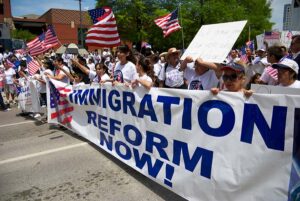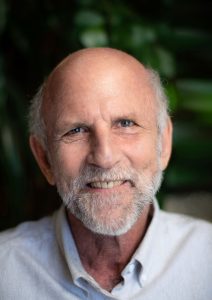 Host Robert Strock introduces an immigration reform framework that unites government agencies, the private sector, and the philanthropic world to provide a viable, safe, legal way for immigrants to enter the United States’ southern border. The plan proposes the creation of fully functional immigrant communities composed of enough tiny homes to house approximately 10,000 people. Residents would work full-time to support the community and neighboring cities. Tiny homes cost ⅕ of traditional low-income housing options and give immigrants a safe, secure place to live while they go through the immigration process. There would also be training opportunities in needed industries such as solar power and regenerative agriculture. Leaders in the regenerative agriculture industry, like Gabe Brown, have already pledged to help in these efforts.
Host Robert Strock introduces an immigration reform framework that unites government agencies, the private sector, and the philanthropic world to provide a viable, safe, legal way for immigrants to enter the United States’ southern border. The plan proposes the creation of fully functional immigrant communities composed of enough tiny homes to house approximately 10,000 people. Residents would work full-time to support the community and neighboring cities. Tiny homes cost ⅕ of traditional low-income housing options and give immigrants a safe, secure place to live while they go through the immigration process. There would also be training opportunities in needed industries such as solar power and regenerative agriculture. Leaders in the regenerative agriculture industry, like Gabe Brown, have already pledged to help in these efforts.
At the same time, residents would go through an immigration process where they are evaluated by administrative staff and their coworkers. This process adds another level of security for the nation. Those that don’t have the character or discipline to become citizens would be deported. The proposed immigration reform framework would reduce the need for police, first responders, medical staff, street violence, jail time detention, and deaths surrounding border crossing and immigration. With congress setting clear limits on immigration numbers, and security built into the communities infrastructure, both sides of the political spectrum can come together. Strock requests listeners to become involved in this important topic and promote immigration reform that benefits the United States, immigrants, and the planet.
Mentioned in this episode
The Global Bridge Foundation
Note: Below, you’ll find timecodes for specific sections of the podcast. To get the most value out of the podcast, I encourage you to listen to the complete episode. However, there are times when you want to skip ahead or repeat a particular section. By clicking on the timecode, you’ll be able to jump to that specific section of the podcast
Transcript
Announcer: (00:00)
The Missing Conversation, Episode 14.
Robert Strock: (00:04)
The communities that are formed will have to have educational opportunities, highlighting learning English, childcare, courthouses on the premises contained in communities. And there needs to be a balance of hard work dignity and a little fun.
Announcer: (00:23)
On this podcast. We will propose critical new strategies to address world issues, including homelessness, immigration, amongst several others, and making a connection to how our individual psychology contributes and can help transform the dangers that we face. We will break from traditional thinking, as we look at our challenges from a freer and more independent point of view. Your host Robert Strock has had 45 years of experience as a psychotherapist, author, and humanitarian, and has developed a unique approach to communication, contemplation, and inquiry born from working on his own challenges.
Robert Strock: (01:02)
Welcome back to The Missing Conversation where we’re addressing the most pressing issues that the world’s facing today and where we look for the most practical and inspiring programs and innovative ideas. Today, we’re going to start with a bold new idea that I don’t think anyone could debate is crucial for our country, which is immigration reform. And with me today is my 50 years long closest friend and partner at the Global Bridge Foundation and much more. Dave, Dave, welcome.
David Knapp: (01:41)
Really appreciate being here. I really really feel this is an important topic for our country. I think the, the White Papers, which are going to talk about that, that you have done on this, uh, are innovative, important, need to get in the right hands, the right people to implement. And I look forward to this very much missing conversation today.
Robert Strock: (02:07)
Thanks, Dave. Uh, this alternative vision for immigration reform definitely qualifies as a missing conversation and it will require a whole system of support between the government, the private sector, and the philanthropic world. I believe it’s a time for the United States to be the leader, not to just create a system that’s never been formed that works, but also to be an inspiration for the rest of the world to emulate, we are proposing facilities along the border with schools, kitchens, living spaces, healthcare, and protection that will be in connection with regenerative agriculture to provide jobs and a nurturing environment while processing and leading toward legal immigration. The communities that are formed will have to have educational opportunities, highlighting learning English, childcare, courthouses on the premises contained in communities. And there needs to be a balance of hard work dignity and a little fun.
David Knapp: (03:24)
And just to be clarifying, one thing we are primarily talking about, what is insanely going on at our Southern border and not that small sliver of what you would call legal immigrants that are already using the system with special skills or other aspects of family immigration to a certain degree, but it’s, it’s this terrifying and terrible and, and horrendous situation that’s going on at our Southern border that we’re primarily talking about.
Speaker 1: (03:59)
Thanks for that clarification. Uh, for those of you that have heard our podcast, you’ll see an overlap in some of the proposals that we’re using for an integration of the unsheltered community in our population and the use of tiny homes. Tiny homes are homes that can be as small as 120 square feet and include a small bathroom and a small kitchenette. And they look nice and can give a very wholesome set of community rather than something that really looks temporary and doesn’t carry that sense, same sense of pride by just looking at it from the outside or from the inside. For that matter what we’re primarily proposing in terms of work is integrating the community with at least the opportunity to bring regenerative agriculture along the border in multiple communities where they will be trained, mentored, and learning a skill that we’ll go into more detail.
Robert Strock: (05:16)
If you don’t know what regenerative agriculture is, what will happen is after the initial infrastructure is set up because there will be hundreds of thousands of acres potentially transformed into regenerative agriculture there’ll be an ability to create a product that will be a huge contribution to all the cities that are nearby. Where these communities are set up the workforce or aspiring immigrants will receive housing and food and would be required to work full time to receive these benefits. And this opportunity, there won’t be any free lunch, but at the same time, they won’t be taken advantage of. One of the most important things to really understand about tiny homes is if you compare it with any kind of traditional housing, it’ll be 1/5th to 1/10th of the cost. And if you compare it to tents or communities that are really in permanent housing, it robs the whole community of a sense of pride and a sense of being well taken care of. Learning skills, which as mentioned, regenerative agriculture would be one of the key ones, is something that prepares all these individuals an opportunity to learn a skill that not only the country needs, but as we dig deeper into it, you’ll see that the world needs as well.
Robert Strock: (07:00)
Also one of the areas that could very well be controversial is if indeed the aspiring migrants are really going to be receiving money. And if so, is it a small stipend? Is it a little bit more than that to help them prepare to come into the country or are the rewards of being extremely well taken care of, their families being extremely well taken care of, having a great diet, learning a profession, being mentored, is that enough where they’re actually receiving great benefit, no matter where they are because they’re learning a trade? So I’m not going to try to answer that question, but I want to just put it out as a question that will have to be resolved by the authorities.
David Knapp: (07:48)
Robert, I want to ask, uh, with respect to regenerative agriculture and the savings you just described about using tiny homes and the, and the products that are going to come from the agricultural efforts and maybe even other efforts that are going on, solar, wind, et cetera. Uh, how does this stack up? Does it pay for itself? Do you, do you feel relative to what’s being expended right now, uh, that the amount of money that this will take out of the budget that’s currently allocated will be offset? Or how does that, how does that sort itself out?
Robert Strock: (08:29)
Once the initial expenses are outlaid for the community to have the tiny homes or trailers, a kitchen where the individuals will have a choice to eat together, or alone, a schoolhouse, a courthouse? Yeah. Security regenerative agriculture has the ability to be growing six to eight crops a year and not only the quantity, but the quality of the soil is enriched through composting, through using animals and their, their poop and their pee, and learning to optimize the use of water. And one of the key things to understand is that regenerative agriculture only requires 10-15% of the water. And so the ability to have intensely healthy soil creates plants that have intensely mineral enriched food. And that can be extremely profitable, even though that won’t be the motive, the motive will be to be useful to the neighboring cities that are nearby, that can clip a head of lettuce or a head of cabbage, and they can eat it within a day.
Robert Strock: (09:55)
And so, yes, definitely as the farm progresses, when you look at the ability to create land in a way that’s going to feed people themselves rather than what is generally happening in two-thirds of the country, which is creating soybeans and corn to feed animals for meat, this is a direct source of extreme health. And at the same time going to communities that really need it. It also, it also has the extra added benefit in its larger scales of pulling carbon down from the atmosphere, which is classically called carbon pull-down, which is a part of the Paris Peace Accord. And that will be a significant part of it as well.
David Knapp: (10:51)
And if I’m not mistaken, this is not theoretical. You have already, in fact, if not, I don’t know if they’re out yet, but have podcasts with people doing this in a significant way inside of the United States.
Robert Strock: (11:06)
Yeah. The person or the places to look up, which I want to give our audience. Gabe Brown has said that he will help us in any way possible. He is currently consulting for 23 million acres of farmland in the United States. And his opening line on one of our podcasts is for skeptics that don’t believe that they can turn their farm that isn’t very profitable into something profitable is I’ll bet you, my 5,000 acre farm, which is a known profitable farming. Anybody in the realm of familiarity with regenerative agriculture, I will bet my 5,000 acre farm against yours. And the only exception is if you’re on the North Pole, the South Pole, on top of a mountain, and he ripples not only with confidence, but with love and true compassion in service, when he, when he’s conveying that our current policies that focus on militarization and policing, which of course will still be needed to some extent would be able to be reduced enormously.
Robert Strock: (12:27)
When we finally have a system that is legal, that is viable, that is way less expensive than the alternatives that are being discussed publicly. And the opportunity to use Gabe as just one name of many that we have that are ready to join the army of support in regenerative agriculture. Also with clean energy of all, of all kinds, the time has come for organization to happen along the border, frugally, intelligently organized to have it be a work opportunity with dignity. And another really key feature that will, I think, put a smile on every American’s face is that during this process, which probably is going to take a year, a year and a half before their case comes up and is submitted to a local courthouse, is that the workers will be evaluated by both their coworkers as to how their work, work ethic is, how skilled they are, how disciplined, and also by the administrative staff that are working with them and the people that are out there in the field.
Robert Strock: (13:59)
And so we have a way that we’ve never had before of adding another level of security by seeing people live for a year. And it’s pretty hard to hide all of, all of who you are, if there’s any apples in there that we need to sort out. And I think it’s likely, although all the determinations will be made by the government that people that rank low on that list will probably not make it because they don’t have the character or the discipline or even worse. They show signs of being dangerous in some way. I believe we have a responsibility for not really enforcing the illegal immigration that’s been going on for such a long time. And this will finally give us or any policy that’s like this, that’s legal, that’s organized that can create benefit that will be safe while we’re doing it, would allow us to have the dignity as a country to say, we have a viable legal immigration policy.
Robert Strock: (15:15)
And now we can feel good about enforcing any illegals that are not entering in the right way. And of course, the powers that be will have to set a clear limit as to how many people are allowed in the country per year in messaging that will not have us have to worry about the throngs coming. And the message will be clear. And the past examples will be clear that they will be absolutely turned away and we will have plenty of curve coverage and ethically and morally be able to feel good about saying no, because we are not here to heal the whole earth ourselves. We certainly want to be a positive influence, but we don’t want to be grandiose and think, come we’ll help rescue, especially when we can’t take good quality care of those that have arrived or teach them skills or have this extra security at it. We will be submitting the White Paper that Dave referenced to the United States, House Judiciary Committee on Immigration and Citizenship and the Sub Committee on the same. And we welcome any support politically to further this cause at every level of government or private sector or philanthropy.
David Knapp: (16:52)
Robert, a question, have you, you, in these proposals and in, in the White Papers or thought through the, the size of these communities, the, the perception based upon mistakes our country, and certainly even currently in other countries are, are happening where there are camps of people segregated. Uh, certainly historically that’s been looked upon as something horrific, uh, keeping these, these folks safe in general. Uh, but also those bad apples. Let’s say those dangerous folks, how, how to, how to really do that, uh, you know, are those details thought through yet? Or is that part of the process that is coming.
Robert Strock: (17:42)
It’s been thought through, but I don’t have any illusion that everybody’s waiting for my report. So yes, this paper is presenting very clear suggestions, but the government will clearly decide. But I believe that something along the lines of 10, 10,000 person communities, not counting staff, would be a manageable amount with enough security around it and all the infrastructure that they could support cities nearby, 10 nearby cities. And that’s assuming that the United States decides that they, they believe they can handle a hundred thousand in a given year. And the proportion would probably be somewhere in that range. Clearly, the facilities have to offer medical care schools to learn English, optimal ways to take care of daycare. So the workers and [unintelligable], both men and women and its design is to have it be sane and balanced, not being overworked and not being underworked. Something like a full-time job where they in their actual experience is saying, I care enough about entering the United States, I’m ready, ready to dedicate a year or whatever time it takes of labor to contribute to the country.
David Knapp: (19:10)
I think that’s so important that statement you just made. I think that justifies a lot of, I think what people have previously resisted, which is that free lunch you mentioned before, it’s like, uh, you know, earning your way in, in a significant way. It matters.
Robert Strock: (19:30)
It matters so much in that sad, extra element that may very well be the most uniting proposal politically in our country today, from everything I have heard, immigration, the desire for immigration, not necessarily the methodology, but the desire for immigration is the number one agreed to issue that needs to happen. And so issues like protection and working and screening is, are issues that would have a tendency to unite the parties. So part of the consideration in this proposal is really being designed to appeal to all parties. There would be, out of necessity, to be some kind of security that would be around every community. And it would be designed that nobody that’s, hasn’t obtained legal immigration would be allowed out of the community unless there was a medical need. And that’s to really allow the people that are most afraid of being invaded, to be secured.
Robert Strock: (20:45)
And that may be some kind of electronic surveillance and human surveillance. And that again, will be up to the local officials to figure out that work could be also in the kitchen. It could be in construction, it could be cleaning up the facilities. It could be solar, of which we already have solar, uh, foundations that are volunteering in the Los Angeles area. I have zero doubt in the public sector and in the philanthropic sector that the capacity to develop clean energy, to develop clean food, healthy food is waiting for us to just organize a plan.
David Knapp: (21:30)
And when you think about 10,000 people communities, and you think about, I mean, that’s, that’s a large number of people that’s, that’s larger than thousands of communities inside the United States. Uh, you’re going to have folks that want to come in that’s that are bilingual already. That can be teachers that can do all kinds of functions, uh, transportation, you know, uh, they’re going to, have to get around the community. That’s a large space. And all of those things are potential job opportunities, training opportunities, things that they can leave with when they put their time in and get approved.
Robert Strock: (22:11)
And as you’re saying that what an incredible opportunity to see people, they have immense value because you have built-in foremen. You have people that already have expertise, and then you have people that don’t know anything and are great learners. And so that discrimination is something it’s hard to imagine that there would be anyone that wouldn’t want to have that extra level of screening that hasn’t been really considered to the best of my knowledge publicly. So if you work out the math, it appears that a hundred thousand people, at $35,000 per unit, that’s adding hookup costs into the costs of trailers or tiny homes, would be three and a half-billion dollars. And then you probably have another billion dollars of houses of various other buildings. So you’re talking about four and a half-billion dollars to set the whole thing up. Now, all of these are round figures in a way they’re best looked at as, uh, let’s say, best guess metaphors.
Robert Strock: (23:22)
But the key point is that it’s relatively inexpensive to set up a system that could last for generations. And one of the key things is we would all have pride and the people coming over would feel well taken care of and have the pride of contributing to the country even before they get here. If you took a shot from a helicopter and you look at the difference between tiny homes and trailers versus temporary shelters, it’s the difference between really looking like you’re not treating people very well versus you’re treating people very well, but also very frugally at the same time, now that the statistics of the United States Bureau of Labor estimates that would cost $30 million for 10,000 people to be taken care of for a year. And when you start to add that up, you start to see that we’re in the worst-case scenario, the low billion, as in one to $5 billion worth of costs to permanently take care of the situation and to preserve the discrimination that it would give.
David Knapp: (24:45)
And please, please remember that’s without the offsets of what the community is creating.
Robert Strock: (24:53)
Exactly, exactly. Now some movies that would be helpful for the audience for you that are listening to watch are The Biggest Little Farm, Sacred Cow, The Need to Grow, and Kiss the Ground. Those are four great movies, as well as Gabe brown has a 16 minute Ted Talk that will give you all you need to know pretty much in a short version of what regenerative agriculture really is and the benefits, not only in health, not only in less water use but in carbon down. Now another feature and another partner in this is John Liu. John Liu is sort of the granddaddy in ecosystem restoration. And what that is, is turning desert areas into Oasis. And from 1994 to 2005, he converted 35,000 square kilometers from desert to Oasis. And he also brings his expertise here. So whatever we can’t convert to farms, we can more quickly convert to lands with animals and all the alternatives and altered water use.
Robert Strock: (26:17)
And that can create immense benefit to have that whole Southern tier suddenly be a rich ground that will have carbon pulled up. There’s no question that this will have a reduced need for police first responders, medical costs, violence, jail time, detention, reduce child expenses, less deaths. If we really let this in and we really go, everyone that’s listening goes to the people they know to really ask for this plan or something equivalent to it. If there’s anything out there that’s equivalent to it, have at it, what matters is, is we have something that’s very doable. Now, if we think about it together and collectively with the various sectors of our economy and the various sectors of government and the various sectors of philanthropy by doing this, we would become not only a leader for our country but a leader for our world and really, uh, a methodology that is a combination of cost-cutting, creating dignity in the communities, working to help the country that you’re wanting to enter and showing the good faith and again discriminating who the most likely to succeed and create benefit and not be dangerous.
Robert Strock: (27:49)
So in this broadcast, we are asking for help. We’re asking for anyone that’s connected to further in whatever way they can, the efforts to have this proposal be part of government and to be able to bypass the political divides that we’re obviously facing. So I thank you for your very rapt attention I hope. And I thank you, Dave. And it’s really a pleasure to be able to get this message out and hope that the urgency of creating an environment and very realistic set of communities is as inspiring to you as it is to us. Thank you very much.
 Join The Conversation
Join The Conversation
If The Missing Conversation sounds like a podcast that would be inspiring to you and touches key elements of your heart, please click subscribe and begin listening to our show. If you love the podcast, the best way to help spread the word is to rate and review the show. This helps other listeners, like you, find this podcast. We’re deeply grateful you’re here and that we have found each other. Our wish is that this is just the beginning.
We invite you to learn more about The Global Bridge Foundation—an organization collaborating to heal communities and the world at TheGlobalBridge.org.
Visit our podcast archive page



